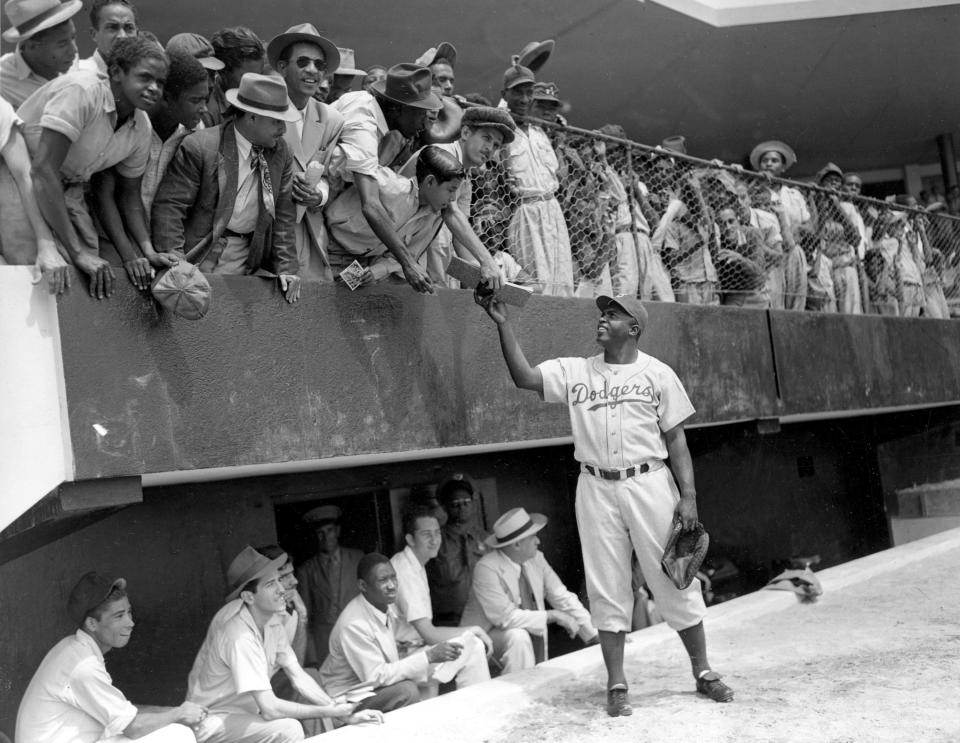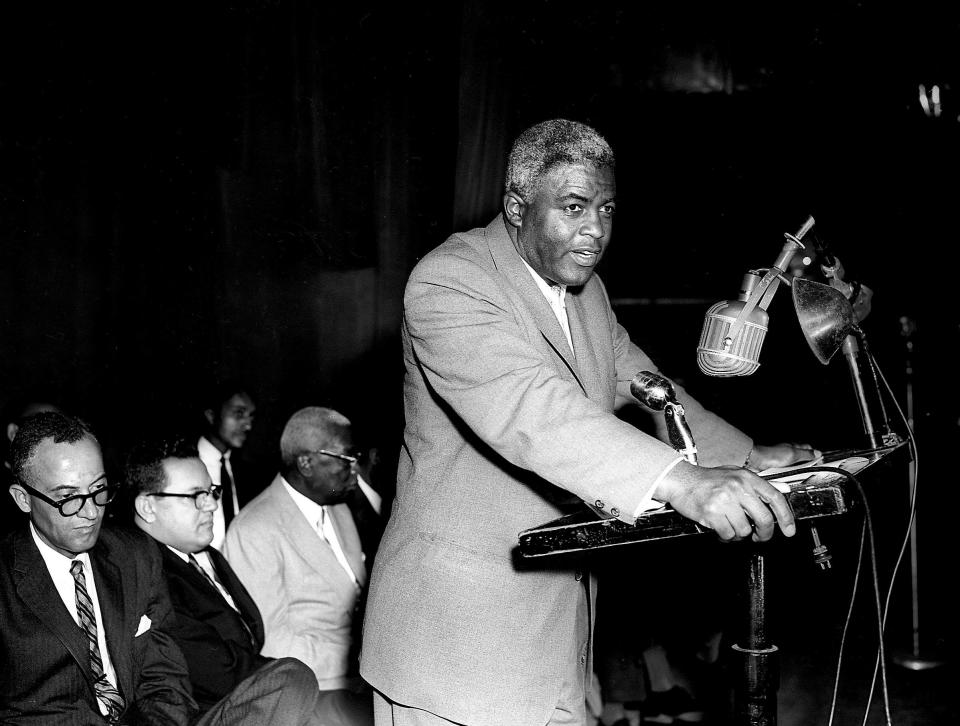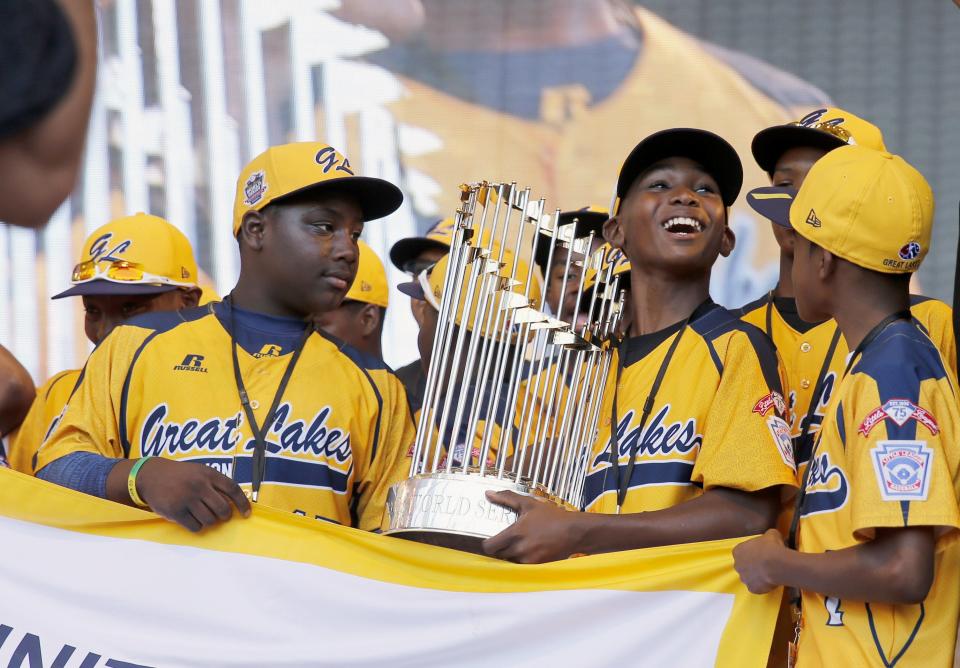Before Jackie Robinson became a baseball icon, he was an elite multisport athlete
April 15 is Jackie Robinson Day. And every year, on Jackie Robinson Day, we celebrate Jackie’s contributions to baseball: his breaking of Major League Baseball’s modern color line, as well as his speed and tenacity that revolutionized the way the game is played in the Majors.
What we don’t talk about is who Jackie was before he joined the Brooklyn Dodgers, namely that he was perhaps the best all-around athlete this country has ever known.
At UCLA, Jackie excelled in football, basketball, track and baseball. He was only the second athlete in school history to letter in four sports. This part we know; these are the stats rattled off in rushed asides, like footnotes. But these details are, in fact, critical. They explain why Jackie was the perfect choice to integrate MLB and, pioneering, barrier-breaking achievements aside, how he became one of the greatest baseball players to ever lace up a pair of cleats.
Another column by Andrea Williams: At South Carolina, Coach Dawn Staley is building a legacy bigger than one player
History records Jackie Robinson's multi-facted dominance
In the winter of 1940, after helping push the Bruins to an undefeated 1939 season, the first in UCLA history, Jackie turned to basketball. He integrated the team and quickly made the foundering program relevant.

On Jan. 12, against Stanford, Jackie scored 23 of UCLA’s 38 points. “Robinson,” wrote Lester Grant of the Oakland Post Enquirer, “living up to all advance notices, staged a first-class exhibition in his debut in conference basketball.” That spring, Jackie won the Pacific Coast Conference’s broad jump title. He also made waves on the baseball diamond.
In a March scrimmage against Cal, Jackie went 4-4 from the plate with three stolen bases, including home. He was also errorless at shortstop, contributing to three double plays, and was brought in as a relief pitcher. “We doubt if there is anything to which he set his hand and mind he couldn’t do,” declared the California Eagle. The accolades kept coming. Ahead of the 1940 football season, Babe Hollingbery, Washington State’s head coach, dubbed Jackie “the world’s greatest athlete.”
And on September 26, just ahead UCLA’s season opener, sportswriter Maxwell Stiles dropped the most complete case for Jackie’s multi-faceted dominance in the Oakland Tribune:
There is little doubt that this man Robinson is today the greatest all-around athlete in the world. Last year he led the Nation in average yards from scrimmage (12 per play) and also topped the country in punt returns (average 20 per run back). He broad jumps 25 feet 6 inches, runs 100 yards in 9.7 seconds, bats over .400 in baseball and topped the Pacific Coast Conference basketball scorers. He plays golf in the low 70s and reached the semi-final of the National tennis championships for the Negro race.
It’s not at all unreasonable to say that, had the NFL not had its own color line when Jackie left UCLA, No. 42 would’ve been a Hall of Fame football player who never again stepped foot on a baseball diamond. What’s more, had the sports climate of the 40s been anything like today’s, Jackie’s baseball exploits would’ve been dismissed well before he had a chance to rewrite history books.
Ace white pitcher Bob Feller, who barnstormed with Satchel Paige and played the regular season in Cleveland, remarked that Jackie had “football shoulders and couldn’t hit an inside pitch to save his neck.” Meanwhile, Black pitcher Hilton Smith, who played with Jackie on the Kansas City Monarchs of the Negro American League, called him “an average fielder.”
Today, a player like the one described by Feller and Smith doesn’t become a first-ballot Cooperstown inductee. Today, that player is forced to make football (or track or basketball) work until it no longer does, with baseball never becoming a viable option.
Where Major League Baseball's diversity aims fall short
On opening day rosters this year, only 6% of Major League players were Black American, a number that harkens back to the mid-1950s, before every MLB team had even one Black player. It’s an issue that is often discussed in conjunction with Jackie Robinson Day, and it’s something that Major League Baseball is clearly working to remedy. Through a number of diversity efforts, numbers of Black American players selected in the first round of the MLB draft has risen, even if that change has yet to be reflected in the Bigs.

Yet for all the progress being made, the fact remains that most of the Black athletes who are able to take advantage of MLB’s diversity initiatives are either lifelong baseball players (picking up a glove as early as 5 or 6), or they’re kids who have already specialized in the sport — that is, they’re on the diamond year-round, eschewing basketball, football and other sports. In some cases, they’re both.
To be clear: This isn’t a bad thing. It says a lot for baseball’s staying power, it’s appeal. And it certainly says a lot to naysayers who justify predominately white rosters across all levels of the sport by suggesting that Black kids just aren’t interested in playing.
But it does nothing for kids who may have come to baseball later, who were forced out of the game by a coach who relegated them to the outfield and the bottom of the lineup, or who, like UCLA-era Jackie, have abilities in other sports that overshadow their still-developing baseball skills.
Professionalization of youth sports hurts kids and the game
Specialization and year-round competition aren’t unique to baseball. AAU basketball means you can hoop through spring and summer long after the winter season is over; even tackle football has taken to the road, with the travel season serving as a sort of bridge between fall and the 7v7 contests of warmer months. But I believe baseball, and its potential participant pool, are most harmed by this professionalization of youth sports.

It doesn’t matter if a kid has never picked up a basketball in his life, if he’s 6’4” in the eighth grade, he’s gonna make somebody’s team. In football, if he’s quick and shifty, somebody’s gonna give him the rock and tell him to run. But baseball, they will tell you, is a game of endless reps, of elusive mastery, of practice that never quite makes perfection. There’s no showing up and making a team based on athleticism and potential. He’s too behind, they’ll say. He’s too raw.
It’s why coaches want kids there for the spring and summer travel season, for fall ball, for all the trainings in between. And if they’re not — whether because their family can’t afford it or because, increasingly, the kid doesn’t want to walk away from football or basketball or track—they lose.
They lose the opportunity to join the most competitive teams with the best coaches. They lose the opportunity to learn how to fail, again and again, because baseball is full of failure. And as they fall further and further behind their specialized contemporaries, these kids lose the opportunity to play at higher and higher levels, to impact the game for generations to come.
They lose, and we lose, too.
Jackie Robinson and Patrick Mahomes had this in common
There were, of course, many reasons why Jackie was chosen to break Major League Baseball’s color barrier, his experience on predominantly white teams and his ability to draw a crowd included. Chief among them, however, was his athleticism.

Jackie may not have been the best baseball player in America when he joined the Monarchs or the Brooklyn Dodgers organization, but he was a competitor. He was elite — the kind of well-rounded, multi-faceted athlete we celebrate when we cheer for Super Bowl quarterback Patrick Mahomes, who loved baseball first.
Those kinds of elite talents are still out there, leaping four feet off the ground for a one-armed touchdown catch and swiveling past defenders on a drive through the paint. They’re there, and baseball needs them. But even as coaches and executives tell us that, we haven’t quite figured out how to pull them into the sport, just as they are.
We should, though. We owe it to the game and to ourselves. And we owe it to one of the greatest all-around athletes to ever live, whose legacy we celebrate every April 15.
Jackie became a baseball player by accident, by nature of racism and segregation and all the ills he would spend his whole life fighting against, even after he hung up his cleats.
But none of those whys matter anymore. All that matters is that he did, and that the baseball — and our world — are better for it.
Andrea Williams is an opinion columnist for The Tennessean and curator of the Black Tennessee Voices initiative. She has an extensive background covering country music, sports, race and society. Email her at [email protected] or follow her on X (formerly known as Twitter) at @AndreaWillWrite.
This article originally appeared on Nashville Tennessean: Honor Jackie Robinson's legacy by increasing accessibility to baseball
